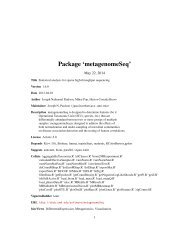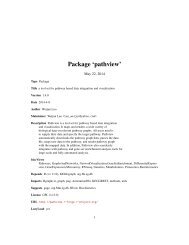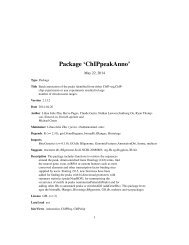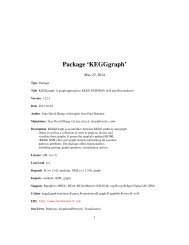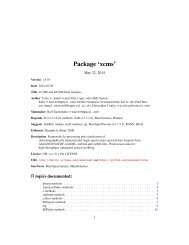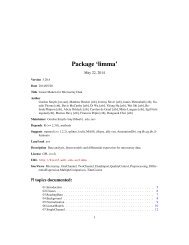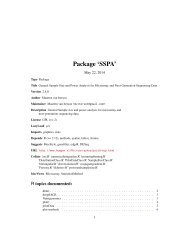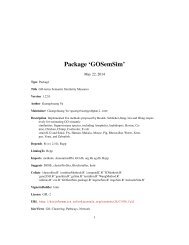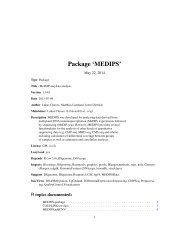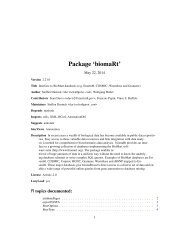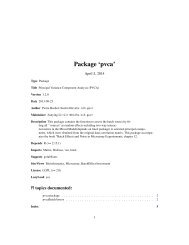Package 'charm' - Bioconductor
Package 'charm' - Bioconductor
Package 'charm' - Bioconductor
You also want an ePaper? Increase the reach of your titles
YUMPU automatically turns print PDFs into web optimized ePapers that Google loves.
<strong>Package</strong> ‘charm’<br />
May 17, 2014<br />
Type <strong>Package</strong><br />
Title Analysis of DNA methylation data from CHARM microarrays<br />
Version 2.10.0<br />
Date 2014-02-27<br />
Author Martin Aryee, Peter Murakami, Harris Jaffee, Rafael Irizarry<br />
Maintainer Peter Murakami <br />
Depends R (>= 2.14.0), Biobase, SQN, fields, RColorBrewer, genefilter<br />
Imports BSgenome, Biobase, oligo (>= 1.11.31), oligoClasses(>=<br />
1.17.39), ff, preprocessCore, methods, stats, Biostrings,IRanges, siggenes, nor1mix, gtools, grDevices,<br />
graphics, utils,limma, parallel, sva(>= 3.1.2)<br />
Suggests charmData, BSgenome.Hsapiens.UCSC.hg18, corpcor<br />
Description This package implements analysis tools for DNA methylation<br />
data generated using Nimblegen microarrays and the McrBC<br />
protocol. It finds differentially methylated regions between<br />
samples, calculates percentage methylation estimates and includes array quality assessment tools.<br />
License LGPL (>= 2)<br />
LazyLoad yes<br />
biocViews Microarray, DNAMethylation<br />
R topics documented:<br />
bgAdjust . . . . . . . . . . . . . . . . . . . . . . . . . . . . . . . . . . . . . . . . . . . 2<br />
clusterMaker . . . . . . . . . . . . . . . . . . . . . . . . . . . . . . . . . . . . . . . . 3<br />
cmdsplot . . . . . . . . . . . . . . . . . . . . . . . . . . . . . . . . . . . . . . . . . . . 4<br />
controlQC . . . . . . . . . . . . . . . . . . . . . . . . . . . . . . . . . . . . . . . . . . 5<br />
countGC . . . . . . . . . . . . . . . . . . . . . . . . . . . . . . . . . . . . . . . . . . . 6<br />
cpgdensity . . . . . . . . . . . . . . . . . . . . . . . . . . . . . . . . . . . . . . . . . . 7<br />
1
2 bgAdjust<br />
dmrFdr . . . . . . . . . . . . . . . . . . . . . . . . . . . . . . . . . . . . . . . . . . . 8<br />
dmrFind . . . . . . . . . . . . . . . . . . . . . . . . . . . . . . . . . . . . . . . . . . . 9<br />
dmrFinder . . . . . . . . . . . . . . . . . . . . . . . . . . . . . . . . . . . . . . . . . . 13<br />
dmrPlot . . . . . . . . . . . . . . . . . . . . . . . . . . . . . . . . . . . . . . . . . . . 16<br />
getControlIndex . . . . . . . . . . . . . . . . . . . . . . . . . . . . . . . . . . . . . . . 17<br />
maxDensity . . . . . . . . . . . . . . . . . . . . . . . . . . . . . . . . . . . . . . . . . 18<br />
methp . . . . . . . . . . . . . . . . . . . . . . . . . . . . . . . . . . . . . . . . . . . . 19<br />
methPercent . . . . . . . . . . . . . . . . . . . . . . . . . . . . . . . . . . . . . . . . . 21<br />
normalizeBetweenSamples . . . . . . . . . . . . . . . . . . . . . . . . . . . . . . . . . 22<br />
normalizeWithinSamples . . . . . . . . . . . . . . . . . . . . . . . . . . . . . . . . . . 23<br />
plotDensity . . . . . . . . . . . . . . . . . . . . . . . . . . . . . . . . . . . . . . . . . 24<br />
plotDMRs . . . . . . . . . . . . . . . . . . . . . . . . . . . . . . . . . . . . . . . . . . 26<br />
plotRegions . . . . . . . . . . . . . . . . . . . . . . . . . . . . . . . . . . . . . . . . . 27<br />
pmQuality . . . . . . . . . . . . . . . . . . . . . . . . . . . . . . . . . . . . . . . . . . 29<br />
qcReport . . . . . . . . . . . . . . . . . . . . . . . . . . . . . . . . . . . . . . . . . . . 30<br />
qval . . . . . . . . . . . . . . . . . . . . . . . . . . . . . . . . . . . . . . . . . . . . . 31<br />
readCharm . . . . . . . . . . . . . . . . . . . . . . . . . . . . . . . . . . . . . . . . . . 34<br />
regionMatch . . . . . . . . . . . . . . . . . . . . . . . . . . . . . . . . . . . . . . . . . 36<br />
regionPlot . . . . . . . . . . . . . . . . . . . . . . . . . . . . . . . . . . . . . . . . . . 37<br />
spatialAdjust . . . . . . . . . . . . . . . . . . . . . . . . . . . . . . . . . . . . . . . . 38<br />
validatePd . . . . . . . . . . . . . . . . . . . . . . . . . . . . . . . . . . . . . . . . . . 39<br />
Index 41<br />
bgAdjust<br />
Remove background<br />
Description<br />
Estimate and remove background signal using anti-genomic background probes<br />
Usage<br />
bgAdjust(dat, copy=TRUE)<br />
Arguments<br />
dat<br />
copy<br />
a TilingFeatureSet<br />
Only relevant when using disk-backed objects. If TRUE a copy will be made<br />
leaving the original object (dat) unchanged. The input object will not be preserved<br />
if copy=FALSE<br />
Details<br />
Background signal removal using a modified version of the RMA convolution model. The background<br />
signal level is estimated within GC-strata using anti-genomic background probes.
clusterMaker 3<br />
Value<br />
a TilingFeatureSet<br />
Author(s)<br />
Martin Aryee <br />
Examples<br />
# See normalizeBetweenSamples<br />
clusterMaker<br />
Redefine array regions given chromosomal coordinates.<br />
Description<br />
Redefine array regions given chromosomal coordinates.<br />
Usage<br />
clusterMaker(chr,pos,order.it=TRUE,maxGap=300)<br />
Arguments<br />
chr<br />
pos<br />
order.it<br />
maxGap<br />
Vector of chromosome names<br />
Vector of positions within chromosomes.<br />
order probes if they are not already ordered.<br />
maximum allowable gap between probe start positions for probes to be grouped<br />
into the same region.<br />
Details<br />
Redefine array regions given chromosomal coordinates.<br />
Author(s)<br />
Martin Aryee , Peter Murakami, Rafael Irizarry<br />
See Also<br />
dmrFind, plotDMRs, plotRegions<br />
Examples<br />
# See qval
4 cmdsplot<br />
cmdsplot<br />
Classical multi-dimensional scaling plot of charm data.<br />
Description<br />
Unsupervised clustering of charm data samples by classical multi-dimensional scaling.<br />
Usage<br />
cmdsplot(labcols, expcol, rawData, p, okqc=1:nrow(p), noXorY=TRUE, outfile="./cmds_topN.pdf", topN=c(1<br />
Arguments<br />
labcols<br />
expcol<br />
rawData<br />
p<br />
okqc<br />
noXorY<br />
outfile<br />
topN<br />
vector of colors, one for each group being plotted (each unique value of pData(rawData)[,expcol])<br />
name of the column of pData(rawData) the values of which the points are colored<br />
differently by.<br />
the TilingFeatureSet object that p came from.<br />
the matrix of percentage methylation values (scale: 0, 1) from using methp on<br />
rawData. One column per sample<br />
vector of indices identifying which rows of p to use.<br />
logical value for whether or not (TRUE or FALSE) to ignore probes in chr X<br />
and Y?<br />
file argument to pdf()<br />
Use only the<br />
Author(s)<br />
Martin Aryee , Peter Murakami, Rafael Irizarry<br />
See Also<br />
regionPlot, dmrFinder, dmrFdr<br />
Examples<br />
# See dmrFdr
controlQC 5<br />
controlQC<br />
Boxplots of control and non-control probes<br />
Description<br />
Usage<br />
Make boxplots of the non-control probes and the control probes (after spatial and background correction<br />
but before any normalization), to confirm that the control probes have a lower distribution<br />
of intensities than the non-control probes.<br />
controlQC(rawData, controlProbes=NULL, controlIndex=NULL, IDcol, expcol, ylimits=c(-6,8), outfile="./b<br />
Arguments<br />
rawData<br />
controlProbes<br />
controlIndex<br />
IDcol<br />
expcol<br />
ylimits<br />
outfile<br />
height<br />
width<br />
a TilingFeatureSet object<br />
character string of the label assigned to non-CpG control probes in the annotation<br />
file (i.e. the container column of the .ndf file) (getContainer reports the<br />
container values for the pm probes). This is used only if controlIndex is not<br />
provided. Either this or controlIndex must be provided.<br />
a vector of non-CpG control probe indices (can be obtained using getControlIndex).<br />
Either this or controlProbes must be provided.<br />
column name of pData(rawData) with which to label samples in the output plot.<br />
name of the column of pData(rawData) by which to order and, if not numeric,<br />
color the boxes.<br />
ylim argument to plot()<br />
file argument to pdf()<br />
height argument to pdf()<br />
width argument to pdf()<br />
Value<br />
A data frame with one row per sample and columns<br />
non_control Median methylation value among the non-control probes<br />
control Median methylation value among the control probes<br />
diff non_control-control<br />
Author(s)<br />
Martin Aryee , Peter Murakami, Rafael Irizarry<br />
See Also<br />
regionPlot, dmrFinder, dmrFdr
6 countGC<br />
Examples<br />
# See dmrFdr<br />
countGC<br />
Count probe GC content<br />
Description<br />
Return the GC content for each probe<br />
Usage<br />
countGC(dat, type = "pm", idx)<br />
Arguments<br />
dat<br />
type<br />
Details<br />
a TilingFeatureSet object<br />
pm or bg probes<br />
idx An optional vector of probe indices for which to return GC content. If not<br />
specified, values for all pm (or bg) probes will be returned.<br />
This function returns the sum of #G + #C in the pm or bg probes.<br />
Value<br />
a numeric vector<br />
Author(s)<br />
Martin Aryee <br />
See Also<br />
readCharm<br />
Examples<br />
if (require(charmData)) {<br />
phenodataDir
cpgdensity 7<br />
cpgdensity<br />
Get CpG density for genomic regions<br />
Description<br />
Calculate the CpG density for a set of windows<br />
Usage<br />
cpgdensity(subject, chr, pos, windowSize = 500, sequence = "CG")<br />
Arguments<br />
subject<br />
chr<br />
pos<br />
windowSize<br />
sequence<br />
BSGenome object (e.g. Hsapiens)<br />
character vector<br />
numeric vector<br />
number value<br />
character string<br />
Details<br />
Calculate the CpG density for a set of regions. chr and pos specify the region mid-points and<br />
windowSize specifies the size of the window to be centered on these mid-points. i.e. The window<br />
will stretch from pos-windowSize/2 to pos+windowSize/2.<br />
Value<br />
a numeric vector<br />
Author(s)<br />
Martin Aryee <br />
Examples<br />
if (require(BSgenome.Hsapiens.UCSC.hg18)){<br />
chr
8 dmrFdr<br />
dmrFdr<br />
Calculate FDR q-values for differentially methylated regions (DMRs)<br />
Description<br />
Estimate false discovery rate q-values for a set of differentially methylated regions (found using<br />
the dmrFinder function) using a permutation approach. For differentially methylated regions found<br />
using the dmrFind function, use the qval function instead.<br />
Usage<br />
dmrFdr(dmr, compare = 1, numPerms = 1000, seed = NULL, verbose = TRUE)<br />
Arguments<br />
dmr<br />
compare<br />
numPerms<br />
seed<br />
verbose<br />
a dmr object as returned by dmrFinder<br />
The dmr table for which to calculate DMRs. See details.<br />
Number of permutations<br />
Random seed (for reproducibility)<br />
Boolean<br />
Details<br />
This function estimates false discovery rate q-values for a dmr object returned by dmrFinder. dmrFinder<br />
can return a set of DMR tables with one or more pair-wise comparisons between groups.<br />
dmrFdr currently only calculated q-values for one of these at a time. The dmr table to use (if the<br />
dmr object contains more than one) is specified by the compare option.<br />
Value<br />
a list object in the same format as the input, but with extra p-val and q-val columns for the tabs<br />
element.<br />
Author(s)<br />
Martin Aryee <br />
See Also<br />
qval, dmrFinder, dmrPlot, regionPlot
dmrFind 9<br />
Examples<br />
if (require(charmData) & require(BSgenome.Hsapiens.UCSC.hg18)) {<br />
phenodataDir
10 dmrFind<br />
Description<br />
Usage<br />
Identify DMR candidates using a regression-based approach and correcting for batch effects.<br />
dmrFind(p=NULL, logitp=NULL, svs=NULL, mod, mod0, coeff, pns, chr, pos, only.cleanp=FALSE, only.dmrs=FA<br />
Arguments<br />
p<br />
logitp<br />
svs<br />
mod<br />
matrix of methylation percentage estimates. Either this or logitp must be provided.<br />
Can be an ff_matrix object.<br />
matrix of logit-transformed methylation percentage estimates. Either this or p<br />
must be provided. Can be an ff_matrix object.<br />
surrogate variables whose effect will be corrected for. This should be svaobj$sv,<br />
where svaobj is the object returned by sva(). Setting svs=0 will result in sva not<br />
being used.<br />
The mod argument provided to sva() which yielded svs. This should be a design<br />
matrix with all the adjustment covariates and (in the rightmost column(s)) your<br />
covariate of interest.<br />
mod0 The mod0 argument provided to sva() which yielded svs. This should be a<br />
design matrix with just the adjustment covariates. Thus it should be the same as<br />
mod, excluding the rightmost column(s) for the covariate of interest.<br />
coeff<br />
pns<br />
chr<br />
pos<br />
only.cleanp<br />
only.dmrs<br />
rob<br />
a character or numeric index for the column of mod that identifies the covariate<br />
column of interest.<br />
vector of region names for the probes corresponding to rows of p or logitp.<br />
vector of chromosomal identifiers for the probes corresponding to rows of p or<br />
logitp.<br />
vector of chromosomal coordinates for the probes corresponding to rows of p or<br />
logitp.<br />
if TRUE, only return the matrix of methylation percentage estimates after removing<br />
the batch effects (columns of sv)<br />
if TRUE, do not return the matrix of methylation percentage estimates that have<br />
had the batch effects (columns of sv) removed (called cleanp).<br />
One of the outputs of dmrFind is cleanp, which is the input p matrix after removing<br />
batch effects identified by SVA. By default these are the only effects<br />
removed from the p matrix. However, if you set rob=FALSE, then the other adjustment<br />
variables in mod and mod0 (all other variables besides the covariate of<br />
interest) are also removed. This will affect the methylation levels shown in plots<br />
using plotDMRs, plotRegions, and any other function that uses the cleanp output<br />
of dmrFind. It does not affect the selection of DMRs, though, except in the<br />
application of the filter at the end of the function where DMRs with an average<br />
difference between the 2 groups (or the average correlation between methylation<br />
and the covariate if the covariate is continuous) of less than the min.value<br />
argument are filtered out, since this step uses the cleanp matrix to calculate those<br />
averages or that correlation.
dmrFind 11<br />
use.limma<br />
smoo<br />
k<br />
SPAN<br />
DELTA<br />
Use the linear modeling approach (borrowing strength across probes) of lmFit<br />
in the limma package.<br />
which method to use for smoothing. "weighted loess", "loess", or "runmed".<br />
k argument to runmed() if smoo="runmed".<br />
see DELTA. Only used if smoo="loess"<br />
span parameter in loess smoothing will = SPAN/(DELTA * number of probes in<br />
the plotted region). Only used if smoo="loess".<br />
use If "sbeta", identify DMRs by segmenting the smoothed effect estimates. If<br />
"swald", identify DMRs by segmenting the smoothed wald statistics.<br />
Q<br />
Details<br />
Value<br />
min.probes<br />
min.value<br />
keepXY<br />
sortBy<br />
verbose<br />
vfilter<br />
nsubsets<br />
Identify DMRs as the consecutive groups of probes whose smoothed effect estimate<br />
(if use="sbeta") or smoothed wald statistics (if use="swald") exceed this<br />
quantile.<br />
The minimum allowable number of probes in a DMR candidate.<br />
The minimum allowable average difference in methylation percentage between<br />
the 2 groups if covariate is categorical, or the minimum average correlation between<br />
methylation and the covariate if covariate is continuous.<br />
if FALSE, exclude DMRs in "chrX" and "chrY".<br />
column of DMR table to sorty by.<br />
print progress messages if TRUE.<br />
vfilter argument to sva function. The number of most variable probes to use<br />
when building SVs–must be between 100 and m, where m is the total number of<br />
probes. vfilter=NULL by default, which means vfilter=m. Setting this to something<br />
smaller, like 100000, will typically yield satisfactory SVs and is advisable<br />
when the size of the data is very large and memory is limited (as when the p<br />
and/or logitp arguments given to dmrFind are ff_matrix objects).<br />
used if p or logitp are ff_matrix objects. Rather than doing computations on<br />
the whole logitp matrix, break up its m rows into chunks of m/nsubsets rows.<br />
Default is 50, but if even that uses too much memory, set this higher. Results do<br />
not depend on the value chosen.<br />
... Additional arguments passed to sva()<br />
Identify DMR candidates using a regression-based approach and correcting for batch effects.<br />
If only.cleanp=TRUE, only the cleanp matrix (below) is returned. Otherwise, the function returns a<br />
list with<br />
dmrs<br />
A data frame with all DMR candidates, with columns:<br />
chr chromosome of DMR<br />
start start of DMR (bp)<br />
end end of DMR (bp)
12 dmrFind<br />
pval<br />
pns<br />
chr<br />
pos<br />
args<br />
value average value of the smoothed effect estimate within the DMR if use="sbeta"<br />
(the default), or the average value of the smoothed wald statistic within the<br />
DMR if use="swald"<br />
area nprobes x value<br />
pns name of the region on the array in which the DMR candidate was identified.<br />
indexStart index of first probe in DMR. This indexes chr, pos, pns, and cleanp<br />
indexEnd index of last probe in DMR. This indexes chr, pos, pns, and cleanp<br />
nprobes number of probes for the DMR, i.e., indexEnd-indexStart+1<br />
avg average (across probes) percentage methylation difference within the DMR<br />
if covariate is categorical, or average (across probes) correlation between<br />
cleanp and covariate if covariate is continuous.<br />
max maximum (across probes) percentage methylation difference within the<br />
DMR if covariate is categorical, or maximum (across probes) correlation<br />
between cleanp and covariate if covariate is continuous.<br />
area.raw nprobes x avg<br />
a vector of p-values for the t-test at each probe (in same order as rows of cleanp)<br />
a vector of probe region names corresponding to the rows of cleanp<br />
a vector of chromosomes corresponding to the rows of cleanp<br />
a vector of positions corresponding to the rows of cleanp<br />
A list containing all the arguments provided to dmrFind. If svs was not provided,<br />
svs here will be the surrogate variables obtained from sva.<br />
If only.dmrs=FALSE,<br />
cleanp<br />
The matrix of percentage methylation estimates, after subtracting batch effects.<br />
If rob=FALSE, the effects of the other adjustment covariates are removed also.<br />
If covariate is continuous,<br />
beta<br />
sbeta<br />
the effect estimate at each probe.<br />
the smoothed effect estimate at each probe.<br />
Author(s)<br />
Martin Aryee , Peter Murakami, Rafael Irizarry<br />
See Also<br />
plotDMRs, plotRegions, qval<br />
Examples<br />
# See qval
dmrFinder 13<br />
dmrFinder<br />
Find differentially methylated regions (DMRs)<br />
Description<br />
Usage<br />
Find differentially methylated regions (DMRs) from tiling microarray data. If you want to adjust<br />
for covariates (including batch effects estimated using SVA) or if your covariate of interest is continuous,<br />
use the dmrFind function.<br />
dmrFinder(eset=NULL, groups, p=NULL, l=NULL, chr=NULL, pos=NULL, pns=NULL,<br />
sdBins=NULL, controlIndex=NULL, controlProbes=NULL, Indexes=NULL,<br />
filter=NULL, package=NULL, ws=7, verbose=TRUE, compare="all",<br />
withinSampleNorm="loess", betweenSampleNorm="quantile",<br />
cutoff=0.995, sortBy="ttarea", removeIf=expression(nprobes
14 dmrFinder<br />
withinSampleNorm<br />
within-sample normalization method. "loess" or "none"<br />
betweenSampleNorm<br />
between-sample normalization method. "quantile", "sqn" or "none"<br />
cutoff<br />
sortBy<br />
removeIf<br />
paired<br />
pairs<br />
DD<br />
Details<br />
Value<br />
COMPS<br />
COMPS.names<br />
t-statistic cutoff used to identify probes as being in a DMR<br />
sort column for the DMR table. "area", "ttarea", "avg.diff", or "max.diff".<br />
expression indicating which DMRs to drop from the DMR tables that get returned.<br />
The negation of this is used as the subset argument to the subset function<br />
when it is called on the final DMR table before it is returned. If NULL, no<br />
DMRs will be subsetted out from the final table before it is returned. DMR table<br />
column names to use are listed below. E.g., to drop all DMRs with less than 4<br />
probes, set removeIf=expression(nprobes
dmrFinder 15<br />
p<br />
l<br />
chr<br />
pos<br />
pns<br />
index<br />
gm<br />
DD<br />
sMD<br />
groups<br />
args<br />
comps<br />
package<br />
indexEnd index of last probe in DMR. This indexes the output of dmrFinder,<br />
*not* the input.<br />
nprobes number of probes for the DMR, i.e., indexEnd-indexStart+1<br />
diff average percentage methylation difference within the DMR (i.e., column<br />
p1 - column p2), if p or eset arguments are provided. Otherwise, if only<br />
l argument is provided, it is the average difference in l (i.e, column m1 -<br />
column m2). Prior to version 2.0.1, if paired=TRUE, this was the average<br />
l (logit(percentage) methylation if l=NULL) difference within the DMR<br />
regardless of whether p or eset were provided.<br />
maxdiff maximum percentage methylation difference within the DMR, if p or<br />
eset arguments are provided. Otherwise, if only l argument is provided, it<br />
is the maximum difference in l. Prior to version 2.0.1, if paired=TRUE, this<br />
was the maximum l (logit(percentage) methylation if l=NULL) difference<br />
within the DMR regardless of whether p or eset were provided. Also prior<br />
to package version 2.0.1, this column was reported only in absolute value,<br />
however, post-version 2.0.1 the sign is retained.<br />
area nprobes x average difference<br />
ttarea nprobes x (average probe level t-statistic for between group difference)<br />
A matrix of percentage methylation estimates (NOTE: the probe order may differ<br />
from that of the input p matrix since probes are sorted into chromosomal<br />
order)<br />
This contains methylation log-ratios if they were passed to the function. Otherwise<br />
it contains logit-transformed percentage methylation estimates. (NOTE:<br />
the probe order may differ from that of the input l matrix since probes are sorted<br />
into chromosomal order)<br />
a vector of chromosomes corresponding to the rows of p and l<br />
a vector of positions corresponding to the rows of p and l<br />
a vector of probe region names corresponding to the rows of p and l<br />
a vector identifying which subset of the input probes (i.e. which elements of the<br />
input chr, pos, and pns, and rows of the input p and/or l) were used to search<br />
for DMRs. The output objects (chr, pos, pns, p, l, etc) are this subset of probes<br />
from the input. Therefore, e.g., while tabs$indexStart:tabs$indexEnd indexes<br />
the elements or rows of the output objects for each DMR candidate in tabs,<br />
index[tabs$indexStart:tabs$indexEnd] indexes the elements or rows of the input<br />
objects.<br />
if paired=FALSE, group medians of the l matrix<br />
if paired=TRUE, a list of within-pair differences for each comparison<br />
if paired=TRUE, a matrix of smoothed mean within-pair differences for each<br />
comparison<br />
a vector of group labels<br />
the DMR finder parameter vector<br />
the vector of pairwise group comparisons<br />
the array annotation package name
16 dmrPlot<br />
Author(s)<br />
Martin Aryee , Peter Murakami, Rafael Irizarry<br />
See Also<br />
dmrFind, readCharm, methp, dmrFdr<br />
Examples<br />
# See dmrFdr<br />
dmrPlot<br />
Plot differentially methylated regions (DMRs) found using the dmrFinder<br />
function.<br />
Description<br />
Usage<br />
Plot differentially methylated regions (DMRs) from tiling microarray data that were identified using<br />
the dmrFinder function. To plot DMRs identified using the dmrFind function, use the plotDMRs<br />
function.<br />
dmrPlot(dmr, which.table=1:length(dmr$tabs), which.plot=1:30, legend.size=1, all.lines=TRUE, all.poin<br />
Arguments<br />
dmr<br />
which.table<br />
which.plot<br />
legend.size<br />
all.lines<br />
all.points<br />
colors.l<br />
colors.p<br />
outpath<br />
cpg.islands<br />
Genome<br />
a list object as returned by dmrFinder.<br />
a vector of indices identifying which tables in the dmr list to plot regions from.<br />
a vector of indices identifying which regions (rows) from each table to plot.<br />
cex argument for the legend (factor by which to magnify/shrink the legend).<br />
if TRUE, plot the smooth lines for all groups. If FALSE, only for the 2 groups<br />
being compared.<br />
if TRUE, plot the points for all groups. If FALSE, only for the 2 groups being<br />
compared.<br />
a vector of line colors, one color for each group whose line is to be plotted (in<br />
alphabetical order).<br />
a vector of point colors, one color for each group whose points are to be plotted<br />
(in alphabetical order).<br />
where to save the output pdf file.<br />
a table with columns "chr","start", and "end" for CpG islands to plot in the<br />
second panel.<br />
the BSgenome object for the organism based upon which your array was designed.
getControlIndex 17<br />
plotG<br />
dat<br />
buffer<br />
plot.p<br />
if TRUE, a third panel of each DMR plot will show the difference between the<br />
median green channel value (after subtracting probe medians and correcting for<br />
gc content) between the 2 groups. If true, dat must be provided.<br />
if plotG=TRUE, this must be provided. It is the TilingFeatureSet object used<br />
when estimating the matrix of percent methylation estimates used in dmrFinder<br />
when it produced dmr.<br />
Number of base pairs to plot on either side of each DMR candidate.<br />
set to FALSE if you want to plot the methlation values (the "l" output from<br />
dmrFinder) instead of the percentage methylation values (the "p" output). If<br />
dmrFinder was run on l instead of p, plot.p=FALSE necessarily.<br />
Details<br />
This function plots the differentially methylated regions (DMRs). The second panel shows the location<br />
of CpG’s with ticks on the bottom (islands are colored) and the location of mcrbc recognition<br />
sites with ticks on the top.<br />
Author(s)<br />
Martin Aryee , Peter Murakami, Rafael Irizarry<br />
See Also<br />
plotDMRs, regionPlot, dmrFinder, dmrFdr<br />
Examples<br />
# See dmrFdr<br />
getControlIndex<br />
Get indices of control probes from CpG-free regions<br />
Description<br />
Get indices of control probes from CpG-free regions.<br />
Usage<br />
getControlIndex(dat, controlProbes = NULL, noCpGWindow = 1000, subject, onlyGood = FALSE, matrix = TRUE)
18 maxDensity<br />
Arguments<br />
dat<br />
controlProbes<br />
noCpGWindow<br />
subject<br />
onlyGood<br />
matrix<br />
TilingFeatureSet<br />
vector of names used to denote control probes in the ’container’ column of the<br />
Nimblegen annotation (ndf) file. Optional<br />
Size of the window centered on the probe that must be CpG-free<br />
A BSgenome object<br />
deprecated option<br />
deprecated option<br />
Details<br />
The probes can either be identified as control probes in the microarray annotation package, or alternatively<br />
the function will search the genome (given an appropriate BSgenome object) for suitable<br />
probes.<br />
Value<br />
a vector<br />
Author(s)<br />
Martin Aryee <br />
Examples<br />
# See dmrFdr<br />
maxDensity<br />
Find the mode of a density function<br />
Description<br />
Calculate a density function and find the max point<br />
Usage<br />
maxDensity(x, n.pts = 2^14, minPoints=30)<br />
Arguments<br />
x<br />
n.pts<br />
minPoints<br />
a data vector<br />
Number of points to use in density estimation<br />
Minimum number of data points to accept
methp 19<br />
Details<br />
This function finds the maximum of a density function. It is identical to the (unexported) max.density<br />
function in affy except that it returns an NA if the number of data points provided is less than<br />
minPoints<br />
Value<br />
a numeric value<br />
Author(s)<br />
Martin Aryee <br />
Examples<br />
x
20 methp<br />
Details<br />
Value<br />
scale<br />
a numeric vector (x,y). The xth percentile of each sample is scaled to represent<br />
y% methylation. The default c(0.99, 0.99) means probes in the 99% percentile<br />
represent 99% methylation.<br />
betweenSampleNorm<br />
between-sample normalization method. Choices are "quantile", "sqn", and "none".<br />
See Details for more fine-grained control.<br />
controlProbes<br />
controlIndex<br />
character string of the label(s) assigned to non-CpG control probes in the array<br />
design file, i.e. in the container column of the .ndf design file for your array. The<br />
getContainer function from the oligo package can be used do see the container<br />
values for all pm probes. This argument is used only if controlIndex is not<br />
provided. Either this or controlIndex must be provided.<br />
a numeric vector of probe indices indicating which pm probes are the non-CpG<br />
control probes (can be obtained using getControlIndex). Either this or control-<br />
Probes must be provided.<br />
excludeIndex a numeric vector of probe indices indicating which pm probes to ignore when<br />
creating the between-array normalization target distributions. These probes are<br />
also removed from all the plots created if plotDensity is specified, however be<br />
aware that they ARE still returned in the output of methp (just without having<br />
had any between-array normalization applied to them).<br />
commonMethPercentParams<br />
boolean indicating whether a common set of parameters should be used for all<br />
samples when converting M-values to percentage methylation.<br />
verbose<br />
returnM<br />
boolean: Verbose output?<br />
boolean. Return M-values without converting to percentage methylation estimates<br />
plotDensity if specified this is the filename of the pdf diagnostic density plots.<br />
plotDensityGroups<br />
numeric vector of group labels used to color lines in the diagnostic density plots<br />
(see plotDensity option)<br />
This function provides probe-level estimates of percentage DNA methylation from CHARM microarray<br />
data.<br />
A matrix of probe-level percentage methylation estimates, one column per sample. If the dat argument<br />
contains ff rather than matrix objects (as when it is produced by readCharm after loading the<br />
ff package), the output will be an ff object.<br />
Author(s)<br />
See Also<br />
Martin Aryee <br />
readCharm
methPercent 21<br />
Examples<br />
# See dmrFdr<br />
methPercent<br />
Estimate percentage DNA methylation from log-ratios<br />
Description<br />
Estimate percentage DNA methylation from log-ratios<br />
Usage<br />
methPercent(m, pmIndex, ngc, commonParams = TRUE)<br />
Arguments<br />
m<br />
pmIndex<br />
ngc<br />
commonParams<br />
a matrix of M-values (methylation log-ratios). One column per sample.<br />
A vector of probe indices to use in the calculation. Usually set to the indices of<br />
the pm probes (excluding background and other non-specific controls) by using<br />
pmIndex=pmindex(dat)<br />
a vector with GC-content of probes. Same length as nrow(m)<br />
boolean indicating whether a common set of parameters should be used for all<br />
samples when converting M-values to percentage methylation.<br />
Details<br />
Value<br />
This function estimates percentage DNA methylation from normalized methylation log-ratios (Mvalues).<br />
a matrix of percentage methylation estimates. Same dimensions as m<br />
Author(s)<br />
Martin Aryee <br />
Examples<br />
if (require(charmData) & require(BSgenome.Hsapiens.UCSC.hg18)) {<br />
phenodataDir
22 normalizeBetweenSamples<br />
# Find non-CpG control probes<br />
ctrlIdx
normalizeWithinSamples 23<br />
Value<br />
a TilingFeatureSet<br />
Author(s)<br />
Martin Aryee <br />
See Also<br />
methp<br />
Examples<br />
if (require(charmData) & require(BSgenome.Hsapiens.UCSC.hg18)) {<br />
phenodataDir
24 plotDensity<br />
Arguments<br />
dat<br />
copy<br />
method<br />
scale<br />
controlProbes<br />
controlIndex<br />
approx<br />
breaks<br />
verbose<br />
a TilingFeatureSet<br />
Only relevant when using disk-backed objects. If TRUE a copy will be made<br />
leaving the original object (dat) unchanged. The input object will not be preserved<br />
if copy=FALSE<br />
normalization method. "loess" or "none"<br />
a numeric vector (x,y). The xth percentile of each sample is scaled to represent<br />
y% methylation. The default c(0.99, 0.99) means probes in the 99% percentile<br />
represent 99% methylation. Set to NA for no scaling.<br />
character string of the label assigned to non-CpG control probes in the annotation<br />
file (i.e. the container column of the .ndf file).<br />
a vector of non-CpG control probe indices<br />
Bin probes by signal intensity when loess normalizing. Much faster when TRUE<br />
Number of bins to use when approx=TRUE<br />
boolean: Verbose output?<br />
Details<br />
Value<br />
This function is used by methp performs within-sample (between-channel) normalization. It is<br />
normally not used directly by the user.<br />
a TilingFeatureSet<br />
Author(s)<br />
Martin Aryee , Rafael Irizarry<br />
Examples<br />
# See normalizeBetweenSamples<br />
plotDensity<br />
Log-ratio density plot for all probes and control probes<br />
Description<br />
Usage<br />
Make density plots of log-ratios for two-color microarray data. Two plots are produced: one for all<br />
probes on the array, and a second for the control probes.<br />
plotDensity(dat, rx = c(-4, 6), controlIndex = NULL, controlProbes=NULL,<br />
pdfFile = NULL, main = NULL, lab=NULL, excludeIndex = NULL)
plotDensity 25<br />
Arguments<br />
dat<br />
rx<br />
controlIndex<br />
controlProbes<br />
pdfFile<br />
main<br />
lab<br />
excludeIndex<br />
a TilingFeatureSet<br />
x-axis range<br />
a vector of non-CpG control probe indices<br />
vector of names used to denote control probes in the ’container’ column of the<br />
Nimblegen annotation (ndf) file.<br />
name of output pdf file<br />
main title<br />
vector of sample labels. If not specified the sample names from dat will be used.<br />
a numeric vector of probe indices indicating which pm probes to ignore when<br />
plotting.<br />
Details<br />
This function makes density plots for a) all probes and b) control probes. It is typically called<br />
from within methp when a file name is specified for its plotDensity option. The plots are useful for<br />
identifying problematic outlier samples.<br />
Value<br />
No return value. Called for its side-effect of producing a pdf plot.<br />
Author(s)<br />
Martin Aryee <br />
Examples<br />
if (require(charmData) & require(BSgenome.Hsapiens.UCSC.hg18)) {<br />
phenodataDir
26 plotDMRs<br />
plotDMRs<br />
Plot differentially methylated regions (DMRs) found using the dmrFind<br />
function.<br />
Description<br />
Usage<br />
Plot differentially methylated regions (DMRs) from tiling microarray data that were identified using<br />
the dmrFind function.<br />
plotDMRs(dmrs, Genome, cpg.islands, exposure, outfile, which_plot=1:50, which_lines=NULL, which_points<br />
Arguments<br />
dmrs<br />
Genome<br />
cpg.islands<br />
exposure<br />
outfile<br />
which_plot<br />
which_lines<br />
which_points<br />
SPAN<br />
DELTA<br />
smoo<br />
ADD<br />
cols<br />
point.info<br />
legend.size<br />
pch.groups<br />
a list object as returned by dmrFind.<br />
the BSgenome object for the organism based upon which your array was designed.<br />
a table with columns "chr","start", and "end" for CpG islands to plot in the<br />
second panel.<br />
The covariate of interest.<br />
the name of the file to save (including the full path)<br />
numeric vector of indices identifying which DMR candidates from dmrs$dmrs<br />
to plot.<br />
vector specifying which groups (unique elements of exposure) to plot the lines<br />
for. If NULL (the default), plots lines for all groups. Only applies if exposure is<br />
categorical.<br />
vector specifying which groups (unique elements of exposure) to plot the points<br />
for. If NULL (the default), plots points for all groups. Only applies if exposure<br />
is categorical.<br />
see DELTA. Only used if smoo="loess"<br />
span parameter in loess smoothing will = SPAN/(DELTA * number of probes in<br />
the plotted region). Only used if smoo="loess".<br />
"loess" for loess smoother or "runmed" for running median smoother (runmed<br />
with k=3). This does not need to be the same as the smoo argument to dmrFind.<br />
Number of base pairs to plot on either side of each DMR candidate (if it is<br />
covered on the array).<br />
vector of colors to use, one for each group (if covariate is categorical)<br />
if TRUE, function returns a table identifying which sample is plotted with which<br />
number or letter (if pch.groups=NULL, the default).<br />
magnification factor for the legend<br />
vector whose length is equal to the number of samples. Each unique value will<br />
be plotted with a different point type.
plotRegions 27<br />
panel3<br />
G<br />
seq<br />
if panel3="G", the third panel of each DMR plot will show the difference between<br />
the median green channel value (after subtracting probe medians and<br />
correcting for gc content) between the 2 groups (i.e., the group defined by<br />
mod[,coef] in dmrFind minus the reference group). If panel="G", seq argument<br />
must be provided. If panel!="G", the 3rd panel will show -log10(dmrs$pval). G<br />
matrix of green channel intensities to use for plotting in the 3rd panel if panel3="G".<br />
vector of probe sequences corresponding to the rows of G (and dmrs$cleanp) if<br />
panel3="G".<br />
Details<br />
This function plots the differentially methylated regions (DMRs) that were identified using the<br />
dmrFind function.<br />
Author(s)<br />
See Also<br />
Martin Aryee , Peter Murakami, Rafael Irizarry<br />
plotRegions, dmrFind, qval<br />
Examples<br />
# See qval<br />
plotRegions<br />
Plot user-provided regions.<br />
Description<br />
Plot user-provided regions.<br />
Usage<br />
plotRegions(thetable, cleanp, chr, pos, seq=NULL, Genome, cpg.islands, exposure, exposure.continuous=F<br />
Arguments<br />
thetable<br />
cleanp<br />
chr<br />
pos<br />
seq<br />
a table with columns for "chr","start", and "end", identifying the genomic regions<br />
to plot (if they are covered on the array).<br />
the matrix of percent methylation estimates to be used for plotting<br />
vector of chromosome labels for the probes in cleanp<br />
vector of chromosomal coordinates for the probes in cleanp<br />
vector of probe sequences corresponding to the rows of G (and cleanp). Needed<br />
only if panel3="G".
28 plotRegions<br />
Genome<br />
cpg.islands<br />
outfile<br />
the BSgenome object for the organism based upon which your array was designed.<br />
a table with columns "chr","start", and "end" for CpG islands to plot in the<br />
second panel.<br />
the name of the file to save (including the full path)<br />
exposure The covariate of interest.<br />
exposure.continuous<br />
set to TRUE if exposure is a continuous variable.<br />
which_lines<br />
which_points<br />
ADD<br />
cols<br />
legend.size<br />
smoo<br />
SPAN<br />
DELTA<br />
panel3<br />
G<br />
grs<br />
Details<br />
vector specifying which groups (unique elements of exposure) to plot the lines<br />
for. If NULL (the default), plots lines for all groups. Only applies if exposure is<br />
categorical.<br />
vector specifying which groups (unique elements of exposure) to plot the points<br />
for. If NULL (the default), plots points for all groups. Only applies if exposure<br />
is categorical.<br />
Number of base pairs to plot on either side of each DMR candidate (if it is<br />
covered on the array).<br />
vector of colors to use, one for each group (if covariate is categorical)<br />
magnification factor for the legend<br />
"loess" for loess smoother or "runmed" for running median smoother (runmed<br />
with k=3).<br />
see DELTA. Only used if smoo="loess"<br />
span parameter in loess smoothing will = SPAN/(DELTA * number of probes in<br />
the plotted region). Only used if smoo="loess".<br />
if panel3="G", the third panel of each DMR plot will show the difference between<br />
the median green channel value (after subtracting probe medians and<br />
correcting for gc content) between the 2 groups (i.e., the group defined by<br />
mod[,coef] in dmrFind minus the reference group). If panel="G", seq argument<br />
must be provided. If panel!="G", the 3rd panel will show -log10(dmrs$pval).<br />
matrix of green channel intensities to use for plotting in the 3rd panel if panel3="G".<br />
if panel3="G", plot difference between the median green channel value (after<br />
subtracting probe medians and correcting for gc content) between these 2<br />
groups.<br />
This function plots user-provided regions.<br />
Author(s)<br />
See Also<br />
Martin Aryee , Peter Murakami, Rafael Irizarry<br />
plotDMRs, dmrFind, qval
pmQuality 29<br />
Examples<br />
# See qval<br />
pmQuality<br />
Calculate probe quality scores<br />
Description<br />
pmQuality calculates probe quality for each pm probe by comparing the total DNA signal (green)<br />
to the distribution of the background probe signals. 0 means lower than all background probes. 100<br />
means higher than all background probes.<br />
Usage<br />
pmQuality(dat, channel="channel1", verbose=FALSE, idx=NULL)<br />
Arguments<br />
dat<br />
channel<br />
verbose<br />
idx<br />
a TilingFeatureSet object<br />
which channel to assess<br />
logical value for whether or not to print message to screen<br />
vector of probe indices specifying which probes to evaluate. By default all pm<br />
probes are used.<br />
Author(s)<br />
Martin Aryee , Peter Murakami, Rafael Irizarry<br />
See Also<br />
regionPlot, dmrFinder, dmrFdr<br />
Examples<br />
# See dmrFdr
30 qcReport<br />
qcReport<br />
Microarray quality report<br />
Description<br />
Calculate microarray quality scores and produce an optional pdf report<br />
Usage<br />
qcReport(dat, file = NULL, utRange = c(30, 100), enRange = c(8, 12),<br />
numProbes = 5e+05, blockSize)<br />
Arguments<br />
dat<br />
file<br />
utRange<br />
enRange<br />
numProbes<br />
blockSize<br />
a TilingFeatureSet<br />
name of output pdf file<br />
color-scale range for the untreated channel plots<br />
color-scale range for the methyl-depleted channel plots<br />
maximum number of probes to use for plots. If smaller than the number of<br />
probes on the array numProbes are chosen at random, speeding up calculations<br />
for high-density arrays with several million probes.<br />
The array is divided into a series of blockSize x blockSize rectangular blocks<br />
and the average signal level calculated for each. If blockSize is unspecified a<br />
size is chosen that gives about 1250 probes per block.<br />
Details<br />
This function calculates microarray quality scores and produces an optional pdf report. Three quality<br />
metrics are calculated for each array:<br />
Average signal strength. The average percentile rank of untreated channel signal probes among<br />
the background (anti-genomic) probes. Since the untreated channel contains total DNA a<br />
successful hybridization would have strong signal for all untreated channel genomic probes.<br />
Untreated channel signal standard deviation. The array is divided into a series of rectangular<br />
blocks and the average signal level calculated for each. Since probes are arranged randomly<br />
on the array there should be no large differences between blocks. Arrays with spatial artifacts<br />
have a larger standard deviation between blocks.<br />
Methyl-depleted channel signal standard deviation<br />
Value<br />
a matrix with a row for each sample. The 3 columns contain array signal strength score, untreated<br />
channel standard deviation and methyl-depleted channel standard deviation.
qval 31<br />
Author(s)<br />
Martin Aryee <br />
Examples<br />
if (require(charmData)) {<br />
phenodataDir
32 qval<br />
fwer.num<br />
statistic, where the null distribution is obtained by simply pooling together all<br />
the statistic vectors from all iterations. If "fwer", the resulting table will have an<br />
additional column ("pvalue.fwer") with the p-value adjusted for control of the<br />
family-wise error rate (obtained as the proportion of maximum statistics (across<br />
all iterations) that are greater than or equal to the observed statistic). More than<br />
one value for method may be specified.<br />
positive integer vector, needed if method argument includes "fwer". For each<br />
number, a separate output column will be returned with the FWER(n)-controlling<br />
adjusted p-values, where FWER(n) is defined as the probability of making n or<br />
more false discoveries (type I errors).<br />
Details<br />
The q-value for region i is estimated by a resampling procedure. It is estimated as x/N, where N is<br />
the number of dmrs in the DMR table returned by dmrFind whose statistic (defined by the sortBy<br />
argument to dmrFind) is >= the statistic for region i, and x is the average (across all iterations’ DMR<br />
tables) number of DMRs with statistic >= the statistic for region i. Monotonicity is then enforced<br />
and q-values are capped at 1. For example, to estimate the q-value for the 5th dmr in your dmr<br />
table that you ranked by area, N is 5. If it has area=100, then x is the average number of dmrs with<br />
area>=100, averaging over all the tables produced by random-resampling iterations. To the extent<br />
that the proportion of the genome covered by the array that is truly non-differentially methylated<br />
is less than 1, x will slightly overestimate the true number of false DMR candidates expected to be<br />
returned from the data, and hence the q-value will be slightly conservative.<br />
The resampling procedure used to obtain null data for each iteration is as follows. 1. Add the<br />
surrogate variables identified by SVA to the null model defined by the mod0 argument to dmrFind,<br />
and obtain fitted methylation values M, where rows correspond to probes and columns correspond<br />
to arrays. 2. Add the surrogate variables identified by SVA to the full model defined by the mod<br />
argument to dmrFind, and obtain residuals R, where rows correspond to probes and columns correspond<br />
to arrays. Then, for iteration k, obtain a column-resampled version of R, Q (resampling with<br />
replacement), and obtain the methylation values to be used in iteration k as M+Q.<br />
Value<br />
the dmr table in your dmr object (dmr$dmrs), with an additional column ("qvalue") for the Fdr q-<br />
value (if method includes "direct"), additional columns for the pooled estimates of the p-values and<br />
q-values (if method includes "pool"), and an additional column for the FWER-adjusted p-values (if<br />
method includes "fwer") (see method argument). There is also a column called qvalue0 which is<br />
just the qvalue column before enforcing monotonicity.<br />
Author(s)<br />
Martin Aryee, Peter Murakami , Rafael Irizarry<br />
See Also<br />
dmrFind, plotDMRs, plotRegions
qval 33<br />
Examples<br />
## See vignette.<br />
if (require(charmData) & require(BSgenome.Hsapiens.UCSC.hg18)) {<br />
dataDir
34 readCharm<br />
withq = qval(p=p, dmr=thedmrs, numiter=2, verbose=FALSE, mc=1)<br />
#### Plotting not run:<br />
## Plot DMR candidates 1,2, and 4, for example. First have to load a table of CpG islands.<br />
cpg.cur = read.delim("http://rafalab.jhsph.edu/CGI/model-based-cpg-islands-hg18.txt", as.is=TRUE)<br />
#plotDMRs(dmrs=thedmrs, Genome=Hsapiens, cpg.islands=cpg.cur, exposure=pd$tissue, outfile="./colon-liver.pd<br />
## Plot DMR candidates, and in the 3rd panel plot the difference in average green channel:<br />
dat0 = spatialAdjust(rawData, copy=FALSE)<br />
dat0 = bgAdjust(dat0, copy=FALSE)<br />
G = pm(dat0)[,,1] #from oligo<br />
G = G[Index,]<br />
#plotDMRs(dmrs=thedmrs, Genome=Hsapiens, cpg.islands=cpg.cur, exposure=pd$tissue, outfile="./colon-liver2.p<br />
## Example if covariate of interest is continuous:<br />
pd$x = c(1,2,3,4,5,6)<br />
mod0 = matrix(1,nrow=nrow(pd),ncol=1)<br />
mod = model.matrix(~1 +pd$x)<br />
coeff = 2<br />
thedmrs2 = dmrFind(p=p, mod=mod, mod0=mod0, coeff=coeff, pns=pns, chr=chr, pos=pos)<br />
## If covariate of interest is continuous, you can still plot it like it is categorical by categorizing it for p<br />
groups = as.numeric(cut(mod[,coeff],c(-Inf,2,4,Inf))) #You can change these cutpoints.<br />
pd$groups = c("low","medium","high")[groups]<br />
#plotDMRs(dmrs=thedmrs2, Genome=Hsapiens, cpg.islands=cpg.cur, exposure=pd$groups, outfile="./test.pdf", wh<br />
## Otherwise, if covariate of interest is continuous, plot will show correlation with covariate:<br />
#plotDMRs(dmrs=thedmrs2, Genome=Hsapiens, cpg.islands=cpg.cur, exposure=pd$x, outfile="./x.pdf", which_plot<br />
## Plot arbitrary regions:<br />
mytable = thedmrs$dmrs[,c("chr","start","end")]<br />
mytable[2,] = c("chr1",1,1000) #not on array<br />
mytable$start = as.numeric(mytable$start)<br />
mytable$end = as.numeric(mytable$end)<br />
#plotRegions(thetable=mytable[1:5,], cleanp=thedmrs$cleanp, chr=chr, pos=pos, Genome=Hsapiens, cpg.islands=<br />
}<br />
readCharm<br />
Read in McrBC/CHARM DNA methylation microarray data<br />
Description<br />
Read in DNA methylation microarray data from the McrBC/CHARM platform<br />
Usage<br />
readCharm(files, path = ".", ut = "_532.xys", md = "_635.xys",<br />
sampleKey, sampleNames = NULL, pkgname, type = NULL, ...)
eadCharm 35<br />
Arguments<br />
files<br />
a vector of xys filenames<br />
path<br />
the path to the xys files<br />
ut<br />
the file ending that designates untreated channel files<br />
md<br />
the file ending that designates methyl-depleted channel files<br />
sampleKey a data frame with sample description information. One line per xys file.<br />
sampleNames a vector of names to use for the samples. One line per xys file.<br />
pkgname the annotation package name<br />
type<br />
deprecated option<br />
... additional options passed on to read.xysfiles2<br />
Details<br />
This function is a convenience wrapper to read.xysfiles2 to simplify reading in DNA methylation<br />
data from the Nimblegen McrBC/CHARM microarray platform. It makes guesses about the extensions<br />
used for the methyl-depleted (md) and untreated channels (ut).<br />
Value<br />
A TilingFeatureSet object. If the ff package is loaded before using this function, the output will<br />
contain ff rather than matrix objects.<br />
Author(s)<br />
Martin Aryee <br />
References<br />
www.biostat.jhsph.edu/~maryee/charm<br />
See Also<br />
methp, dmrFinder<br />
Examples<br />
# See normalizeBetweenSamples
36 regionMatch<br />
regionMatch<br />
Given two data frames with columns "chr", "start", and "end", identify<br />
the nearest region in one to the other.<br />
Description<br />
Usage<br />
Given two data frames with columns "chr", "start", and "end", identify the nearest region in one<br />
(object2) to the other (object1).<br />
regionMatch(object1, object2, verbose=TRUE)<br />
Arguments<br />
object1<br />
object2<br />
verbose<br />
Data frame with columns "chr", "start", and "end". For each of the rows of this<br />
data frame, find the nearest regions in object2.<br />
Data frame with columns "chr", "start", and "end".<br />
print progress.<br />
Details<br />
Value<br />
Given two data frames with columns "chr", "start", and "end", identify the nearest region in one<br />
(object2) to the other (object1).<br />
A data frame with one row corresponding for each row of object1, and columns:<br />
dist bp separating the region in object1 and the nearest region in object2<br />
matchIndex row index of object2 for the region that is closest to the region in object1<br />
type "inside" if nearest region in object2 is wholly contained inside the region in object 1, "cover"<br />
if nearest region in object2 covers the whole region in object1, "disjoint" if there is no overlap<br />
between the region in object1 and the nearest region in object1, and "overlap" if the region in<br />
object1 and the nearest region in object2 overlap but one does not wholly cover the other.<br />
amountOverlap amount of overlap between the region in object1 and the nearest region in object2<br />
insideDist for type="inside" regions, the smaller (fewest bp) of 1., the end position of region in<br />
object1 - the end position of the nearest region in object2, and 2., the start position of region<br />
in object1 - the start position of the nearest region in object2.<br />
size1 number of bp in region in object1<br />
size2 number of bp in nearest region in object2<br />
Author(s)<br />
Martin Aryee , Peter Murakami, Rafael Irizarry
egionPlot 37<br />
See Also<br />
dmrFind, plotDMRs, plotRegions<br />
Examples<br />
# See qval<br />
regionPlot<br />
Plot user-supplied genomic regions using data returned by the dmrFinder<br />
function.<br />
Description<br />
Usage<br />
Plot any given genomic regions from tiling microarray data using data returned by the dmrFinder<br />
function.<br />
regionPlot(tab, dmr, cpg.islands, Genome, outfile="./regions.pdf", which.plot=1:10, plot.these, cl, le<br />
Arguments<br />
tab<br />
dmr<br />
cpg.islands<br />
Genome<br />
outfile<br />
which.plot<br />
plot.these<br />
cl<br />
legend.size<br />
buffer<br />
plot.p<br />
a data frame with columns chr, start, and end identifying the regions to be plotted<br />
from the data.<br />
a list object as returned by dmrFinder, providing the data to be plotted.<br />
a table with columns "chr","start", and "end" for CpG islands to plot in the<br />
second panel.<br />
the BSgenome object for the organism based upon which your array was designed.<br />
a character string giving the name of the pdf file that will be saved. Include the<br />
full path if file is not to be saved in the current working directory.<br />
a vector of indices identifying which regions (rows) from tab to plot.<br />
if dmr results are from unpaired analysis, specify the groups to plot. Default is<br />
colnames(dmr$gm). If dmr results are from paired analysis, specify the comparisons<br />
to plot. Default is colnames(dmr$sMD).<br />
a vector of line and point colors, one for each element of plot.these in alphabetical<br />
order by group name.<br />
cex argument for the legend (factor by which to magnify/shrink the legend).<br />
An integer to control how many basepairs to show on either side of the plotted<br />
regions.<br />
set to FALSE if you want to plot the methlation values (the "l" output from<br />
dmrFinder) instead of the percentage methylation values (the "p" output). If<br />
dmrFinder was run on l instead of p, plot.p=FALSE necessarily.
38 spatialAdjust<br />
plotG<br />
dat<br />
grs<br />
if TRUE, a third panel of each DMR plot will show the difference between the<br />
median green channel value (after subtracting probe medians and correcting for<br />
gc content) between the 2 groups. If true, dat must be provided.<br />
if plotG=TRUE, this must be provided. It is the TilingFeatureSet object used<br />
when estimating the matrix of percent methylation estimates used in dmrFinder<br />
when it produced dmr.<br />
if plotG=TRUE, this must be provided. It is the names of the two groups whose<br />
difference in G should be plotted in the 3rd panel.<br />
Details<br />
This function enables plotting of any regions, not just DMRs, using the results of dmrFinder. The<br />
second panel shows the location of CpG’s with ticks on the bottom (islands are colored) and the<br />
location of mcrbc recognition sites with ticks on the top.<br />
Author(s)<br />
Martin Aryee , Peter Murakami, Rafael Irizarry<br />
See Also<br />
plotRegions, dmrPlot, dmrFinder, dmrFdr<br />
Examples<br />
# See dmrFdr<br />
spatialAdjust<br />
Correct spatial artifacts<br />
Description<br />
Remove spatial artifacts from microarray data stored in TilingFeatureSet objects<br />
Usage<br />
spatialAdjust(dat, copy=TRUE, blockSize, theta = 1)<br />
Arguments<br />
dat<br />
copy<br />
blockSize<br />
theta<br />
TilingFeatureSet<br />
Only relevant when using disk-backed objects. If TRUE a copy will be made<br />
leaving the original object (dat) unchanged. The input object will not be preserved<br />
if copy=FALSE<br />
The array is divided into a series of blockSize x blockSize rectangular blocks<br />
and the average signal level calculated for each. If blockSize is unspecified a<br />
size is chosen that gives about 1250 probes per block.<br />
smoothing parameter
validatePd 39<br />
Details<br />
Value<br />
The array is divided into a set of blockSize x blockSize squares. A kernel smoother is then used to<br />
even out spatial artifacts.<br />
a TilingFeatureSet<br />
Author(s)<br />
Martin Aryee <br />
Examples<br />
# See normalizeBetweenSamples<br />
validatePd<br />
Validate a sample description file for two-color microarray data<br />
Description<br />
Usage<br />
Checks a sample description file describing two-color arrays for proper formatting and if requested<br />
guesses column numbers for file names, sample labels and group labels.<br />
validatePd(pd, fileNameColumn, sampleNameColumn, groupColumn,<br />
ut = "_532.xys", md = "_635.xys")<br />
Arguments<br />
pd<br />
A data frame containing the sample description table<br />
fileNameColumn Number or name of column containing file names (optional)<br />
sampleNameColumn<br />
Number or name of column containing sample names (optional)<br />
groupColumn<br />
ut<br />
md<br />
Details<br />
Number or name of column containing group labels (optional)<br />
the file ending that designates untreated channel files<br />
the file ending that designates methyl-depleted channel files<br />
This function checks the formatting of a sample description file to make sure it has suitable columns<br />
for file names, sample names and (optionally) group labels. The sample description file should have<br />
one line per channel, i.e. two lines per sample corresponding to the red and green channel data files.<br />
Values in the sample name column are used to pair the two channels together. If fileNameColumn,<br />
sampleNameColumn and/or groupColumn are unspecified a guess will be made.
40 validatePd<br />
Value<br />
If the input data frame is valid: a list containing the fileNameColumn, sampleNameColumn and<br />
groupColumn. If the input data frame is invalid: FALSE<br />
Author(s)<br />
See Also<br />
Martin Aryee <br />
readCharm<br />
Examples<br />
# See dmrFdr
Index<br />
bgAdjust, 2<br />
clusterMaker, 3<br />
cmdsplot, 4<br />
controlQC, 5<br />
countGC, 6<br />
cpgdensity, 7<br />
dmrFdr, 4, 5, 8, 16, 17, 29, 38<br />
dmrFind, 3, 9, 16, 27, 28, 32, 37<br />
dmrFinder, 4, 5, 8, 13, 17, 29, 35, 38<br />
dmrPlot, 8, 16, 38<br />
getControlIndex, 17<br />
maxDensity, 18<br />
methp, 16, 19, 22–24, 35<br />
methPercent, 21<br />
normalizeBetweenSamples, 22<br />
normalizeWithinSamples, 23<br />
plotDensity, 24<br />
plotDMRs, 3, 12, 17, 26, 28, 32, 37<br />
plotRegions, 3, 12, 27, 27, 32, 37, 38<br />
pmQuality, 29<br />
qcReport, 30<br />
qval, 8, 12, 27, 28, 31<br />
readCharm, 6, 16, 20, 34, 40<br />
regionMatch, 36<br />
regionPlot, 4, 5, 8, 17, 29, 37<br />
spatialAdjust, 38<br />
validatePd, 39<br />
41



